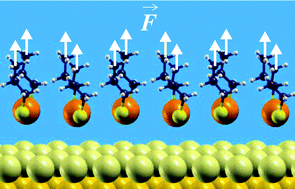Force-induced mechanical response of molecule–metal interfaces: molecular nanomechanics of propanethiolate self-assembled monolayers on Au(111)
Abstract
Density-functional theory calculations of propanethiolate self-assembled monolayers at the Au(111) surface have been carried out to study the response properties of organic adlayers at metal surfaces to externally applied mechanical forces. “Force maps” are introduced in order to systematically quantify the system's nanomechanical response to both the magnitude and direction of the external forces applied here in an isotensional setup. Depending on the direction and magnitude of the forces we find that there are two dominant phenomena for the most stable c(4 × 2) structure containing two propanethiolate gold adatom adsorbate complexes C3S–Auad–SC3 per unit cell: a sliding of the complete topmost metal layer including adsorbates or the detachment of the thiolate–adatom complexes only. Investigations of the atomistic mechanisms show that the initial configuration of the bulky C3S–Auad–SC3 complexes is responsible for sizable variations in the effective barrier heights for different force directions. A lateral force along the [1![[1 with combining macron]](https://www.rsc.org/images/entities/char_0031_0304.gif) 0] direction with magnitude between 0.6 nN and 1.4 nN induces a plane sliding of the complete outermost Au(111) layer. In contrast, a force normal to the surface induces a detachment of the thiolate complexes if the force exceeds a threshold value of about 1.4 nN, which is in excellent agreement with experimental results. The use of tilted pulling directions, i.e., applying forces with nonzero normal and lateral components, facilitates the removal of the adsorbate complexes even at notably smaller force magnitudes. This mechanochemical promotion is traced back to a destabilization of the molecule–metal interface as a result of a (slight) lateral displacement to energetically unfavorable sites, thereby weakening chemical bonding of adsorbate complexes to the substrate. These observations are vastly different from what has been found for single molecule pulling normal to the surface, where
0] direction with magnitude between 0.6 nN and 1.4 nN induces a plane sliding of the complete outermost Au(111) layer. In contrast, a force normal to the surface induces a detachment of the thiolate complexes if the force exceeds a threshold value of about 1.4 nN, which is in excellent agreement with experimental results. The use of tilted pulling directions, i.e., applying forces with nonzero normal and lateral components, facilitates the removal of the adsorbate complexes even at notably smaller force magnitudes. This mechanochemical promotion is traced back to a destabilization of the molecule–metal interface as a result of a (slight) lateral displacement to energetically unfavorable sites, thereby weakening chemical bonding of adsorbate complexes to the substrate. These observations are vastly different from what has been found for single molecule pulling normal to the surface, where


 Please wait while we load your content...
Please wait while we load your content...